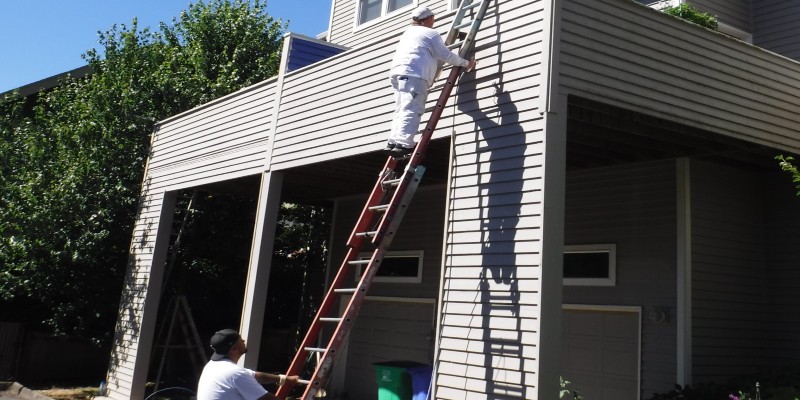3 MIN READ
When Painting Homes We Take Ladder Safety Seriously
We work on everything from the ground up on your beautiful home, and a lot of the time, the work we perform requires the use of ladders and ladder safety. Whether we are working from them to paint higher places or using them to gain access to the roof, eaves, or attic, ladders are a fantastic tool. We couldn’t do most of what we do without one. But a damaged ladder or a ladder being misused can be a dangerous thing and definitely not the safety guidelines that were recommended. Always inspect your ladder to make sure it’s in good working condition. If it is damaged or missing parts don’t use it, It’s not worth the risk of a fall.
Proper Use Of Extension Ladders
Some areas require the use of an extension ladder. The placement is a big deal with these types of ladders to keep the bottom from sliding out from under you, and the top against the wall and not falling backward with you on it. The base of the extension ladder should be one foot out for every four feet high. If your accessing a roof, your top rung should be three feet above the surface. Stacking items under a ladder to level it is risky and unsafe. If something shifts the ladder, it can slip out from under the ladder and send you falling. If possible, tie your ladder off to something substantial and secure the ladder to ensure the ladder doesn’t slip or slide out from the wall.
Portable Ladders
A portable ladder unfolds into a self-standing pyramid with rungs on one or both sides. This type of ladder allows us to access high points in the middle of rooms and avoid leaning the ladder on finished walls. To safely use one of these types of ladders, make sure you have a reasonably level surface to set it on. Maintain three points of contact while climbing and keep your body close to the center of the ladder to keep the center of gravity centered.
Be Sure To Choose The Right Ladder For The Job With All Safety Requirements Needed
There are many different types of ladders and uses for those ladders. Make sure you’re using the right kind of ladder for what you’re doing. Please read the manufacturers specifications and limitation for the ladder your using and follow them. Some ladders well have locking joints in multiple places; be sure and check these locking points before using the ladder, or it could fold on you while you’re on it. All ladders will have a weight limit. Never overload your ladder; the weight limit is there for a reason to follow it and be safe. The use of none slip shoes when climbing a ladder can make a big difference, and make sure your laces are tied. The bottom of your boots is clear of mud or anything that might affect your traction on the ladder rungs.
Don’t Become The Next Ladder Safety Statistic
Follow all ladder safety precautions, rules, and guidelines. Only one person should be on a ladder at a time and always face the ladder while on it. Lousy weather and or high winds can make it dangerous to use ladders. Statistics show that roughly 20 percent of all fall injuries happen on ladders, and 81 percent of construction worker falls that end up in the emergency room are from ladders. Every year there are around 300 deaths caused by ladder falls and more than 164,000 emergency room visits. It only takes a ten-foot fall to kill you. So again, inspect your ladder for damaged or missing parts. Be sure your ladder is level and secure, one foot out on the bottom for every four-foot-high, non-slip clean shoes, facing the ladder and keeping three points of contact. Keep your weight centered, one person at a time on the ladder, and avoid high winds and icy weather while working on a ladder.


